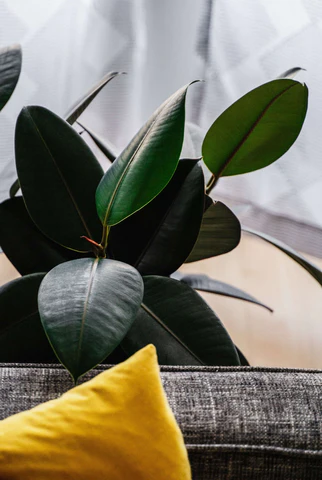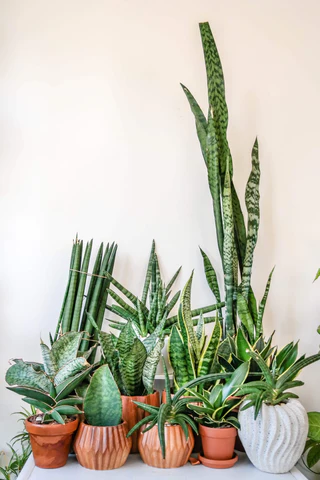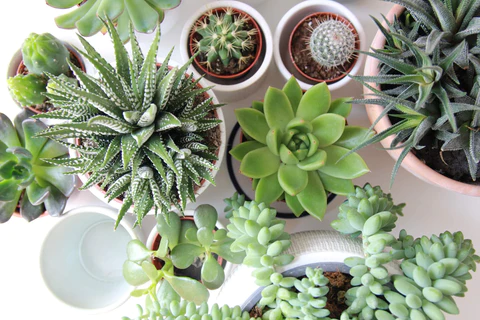9 Plants To Reduce Stress + Increase Productivity
No matter whether you’re a seasoned horticulturist, a self-described “plant mom,” or a notorious black thumb, you’ll find value in choosing your plants based on not just their looks, but also their ideal environment and their wellness properties.

PLANTS WITH BENEFITS
All plants have beneficial wellness properties in some form or another. Plants can not only enhance the overall appearance of a space, but studies have shown indoor plants can also boost moods, enhance creativity, increase productivity, reduce stress levels, bring tranquility, maintain indoor humidity levels, produce oxygen, and naturally filter air pollutants. They’re pretty insane multitaskers. While plants, in general, can be beneficial to your well-being, some have particular attributes that make them great additions to your space.
Aloe Vera
Aloe Vera is purifying in that it removes benzene and formaldehyde from the air. But its properties go far beyond producing clear indoor air: The ‘gel’ inside the [aloe vera] leaves can soothe and heal minor skin irritations such as burns and cuts. The clear liquid is also said to have antibacterial and anti-inflammatory properties. To use aloe vera to its full potential, cut off a mature bottom leaf, split it open, and squeeze out the gel.
Kimberly Queen Fern
This handy plant is great in colder months to help combat winter skin. Boston and Kimberly Queen Ferns are said to be natural humidifiers and are a great choice if the air moisture is low in your home. The leafy green also has purifying properties: It removes formaldehyde, xylene, and toluene from the air. And they’re pet-friendly.
Ponytail Palm
For heightened productivity, the ponytail palm is a fantastic addition to your home. Ponytail palms absorb carbon dioxide, which can contribute to drowsiness and headaches, and they release oxygen. They are interesting-looking plants that make a bold statement with very low water needs. Add this one to your desk at home or at work.

IN YOU WANT TO CLEAR THE AIR
All plants purify the air by removing carbon dioxide and adding oxygen, but some plants are real powerhouses, like the Sansevieria [or snake plant] which, unlike most plants, also releases oxygen into the air at night because they can perform a type of photosynthesis which not all plants can do. Plants do a better job cleaning the air when they have more light. What experts are finding is that the amount of light a plant has access to really impacts its ability to produce o2. So if you really want to clean the air, bring in a lot of plants and put them in bright light.
Rubber Plant
This beauty can tolerate medium light and is fairly easy to care for. It has a high transpiration rate, meaning it releases more water into the air than some other plants, helping to make spaces feel more humid and comfortable. This plant is very tolerant of neglect and can be grown with very little experience. Beyond its beautiful burgundy leaves, there is one more reason to bring this powerhouse in your space: Rubber plants are known to reduce mold and bacteria in any room by as much as 50 percent.

Snake Plant
This insanely low-maintenance plant claims a spot on NASA’s [most purifying plant] list. Snake plants have been shown to filter multiple toxins: benzene, formaldehyde, trichloroethylene, xylene, and toluene. This columnar plant can thrive in a number of different lighting situations. The plant does most of its work at night, converting carbon dioxide to oxygen as you sleep. It’s one of the most popular options for improving air quality, which makes it a great choice for the bedroom.
Spider Plant
Native to southern Africa, spider plants are also known for their tremendous air purifying properties. They’re also fast-growing and nearly impossible to kill, making them healthy additions to any area of the home, from the tabletop to the mantel. “It’s a no-fuss whimsical plant with lovely arching striped leaves,” explains Mast. “It’s easy to care for, making it a great choice for beginners.” She also notes that the plant removes formaldehyde, toluene, and xylene from the air and is pet-friendly.

PLANTS WITH NO STRINGS ATTACHED
Pick greenery that fits your space and lifestyle. Go-tos for apartment dwellers are plants in the Sansevieria family. These are incredibly versatile plants—they can thrive in both high light and low light spaces and are very forgiving of irregular watering, so they’re perfect for people who travel or forget to water their plants.
ZZ Plant
The ZZ, or Zamioculcas Zamiifolia has gloriously glossy leaves, a beautiful shape, and is incredibly hardy. As long as you don’t over-water it, the ZZ can thrive in just about any space. It can adapt to various lighting situations from rooms with absolutely no natural light to indirect bright light, which makes the plant ideal for people who move often. The ZZ plant (or the smaller Zenzi) is a survivor– it can go for weeks without water. Ignore this plant, and it will be the happiest. It’s perfect for a windowless bathroom or dimly lit corner of your home.
Pothos
The Pothos is another popular alternative for self-described black thumbs. If you have much lower light, try an equally hardy but less drought-tolerant Pothos plant. Affectionately nicknamed the ‘cubicle plant’ because it can tolerate less-than-ideal conditions, it’s a fast-growing, trailing tropical plant. Try moderate, indirect light and watering it once every 12 days. It removes benzene, formaldehyde, toluene, and xylene from the air. The Golden Pothos is an attractive, cascading, easy houseplant that looks stunning on shelves, dressers, and side tables where it can show off its beautiful bright green-and-yellow foliage.
Succulents
If you have bright, direct light, succulents are low-maintenance and easy to grow. We are big fans. Our favorite hardy succulent varieties are Haworthia, aloe, and Echeveria. They sometimes get a bad rap because people either don’t have enough light for them or overwater them. But if you put them in bright, direct light and water about once a month, they’ll do just fine. If they begin to wrinkle, it means that they’re thirsty.
